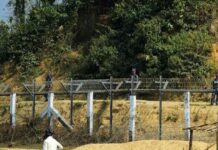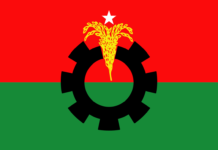
Thousands of garment workers rampaged through industrial areas of the capital of Bangladesh on Friday, smashing vehicles with bamboo poles and setting fire to at least two factories in violent protests ignited by a deadly building collapse this week that killed at least 304 workers.
The protests came as rescue teams spent a third day searching for survivors in the rubble of the building, the Rana Plaza, in a suburb of the capital, Dhaka. Officials reported that 72 people were pulled out alive, a rare bit of good news in what is already considered the deadliest accident in the history of the garment industry — with a death toll expected to keep rising.
Prime Minister Sheikh Hasina ordered the arrests of the owner of Rana Plaza, as well as the owners of four garment factories that were operating on the upper floors of the eight-story building. Pressure also mounted on Western clothing brands that rely heavily on Bangladesh to manufacture their products; labor activists have found labels inside the wreckage for clothes being made for J. C. Penney, Cato Fashions, the British retailer Primark and other clothing brands.
Two of the factory owners turned themselves in to the police early on Saturday, bdnews24.com, an online newspaper, reported.
A special government committee has been appointed to investigate the accident, and questions are already arising about why more than 3,000 employees were working at Rana Plaza when it collapsed on Wednesday morning. Cracks had been discovered in the structure a day earlier, and police officials and industry leaders say they had asked the factory bosses to stop work until the building had been inspected.
“I wouldn’t call it an accident,” the government’s information minister, Hasanul Haque Inu, told Bangladeshi journalists. “I would say it’s a murder.”
Friday’s violent protests ricocheted among industrial sections of Dhaka as garment workers took to the streets to vent their fury. Many of the protesters demanded the death penalty for Sohel Rana, the owner of the building, as well as the owners of the garment factories on the upper floors. More than 150 vehicles were reported damaged, and some protesters burned two factories.
In Narayanganj, an industrial district near the capital, protesters vandalized at least five garment factories and clashed with the police, who responded with rubber bullets and tear gas.
Ten people were injured and nearly two dozen workers were arrested on vandalism charges after demonstrations halted traffic on a major road.
Labor groups in the United States on Friday distributed photos showing that they had discovered garments with labels from J. C. Penney and El Corte Inglés, the Spanish retailer, at the site of the collapse. Seeking to press American retailers to do more to assure factory safety in Bangladesh, dozens of worker advocates held protests on Thursday at the Gap’s headquarters in San Francisco and at a Walmart store in Renton, Wash.
A leading factory monitoring group, the Business Social Compliance Initiative, which is based in Brussels, said that two of the factories in the building — New Waves Style and Phantom Apparel — were inspected and had complied with the group’s code of conduct.
Another factory in the building, Ether Tex, said on its Web site that it had passed an inspection by a monitoring group in Düsseldorf, Germany, the Service Organization for Compliance Audit Management. The Web site said Ether Tex was being evaluated by the Business Social Compliance Initiative.
Officials from such monitoring groups say they generally focus on internal matters, like smoke detectors and whether exit doors are locked, and not on matters like fire escapes or the soundness of a building’s structure, which are normally the responsibility of government inspectors.
Labor activists and human rights groups called on retailers and global brands to help pay for programs to improve factory safety and upgrade fire prevention equipment, a need underscored by a November fire that killed 112 workers. Activists say that spending about $600 million a year for five years could bankroll sweeping improvements to the country’s 5,000 garment factories — noting that global brands could finance such a program by agreeing to pay an additional 10 cents per garment for the more than six billion articles of clothing exported each year.
Leaders of two Bangladesh garment industry trade groups announced Friday that factories in their association would close for the weekend so that workers could aid in the rescue efforts at Rana Plaza. Atiqul Islam, president of the Bangladesh Garment Manufacturers and Exporters Association, called on the owner of Rana Plaza and the owners of the factories inside the building to surrender to the authorities.
Mr. Islam also said that the trade group would hire engineers to examine the structural stability of all the country’s garment factories.
The Bangladeshi military has established a command center near Rana Plaza to coordinate rescue efforts. Teams of soldiers, paramilitary police officers and ordinary citizens were carefully digging through the rubble, sometimes with their bare hands.
Source: NYTimes









